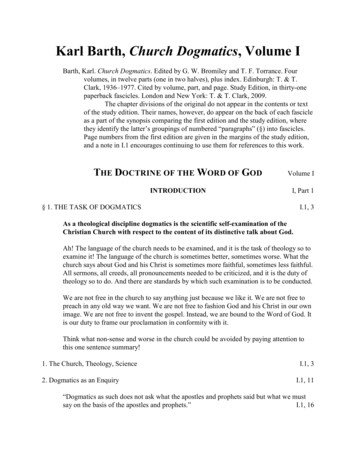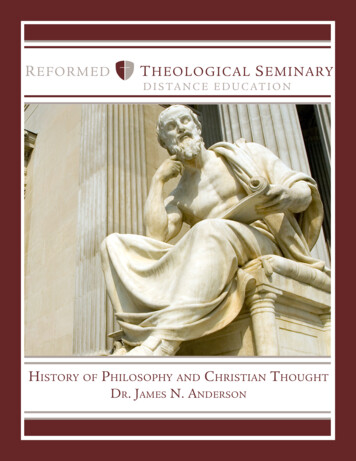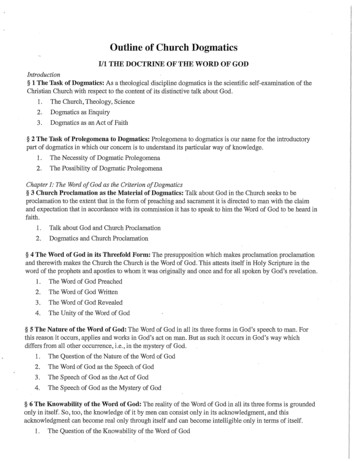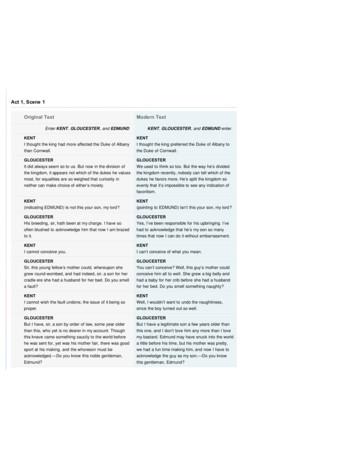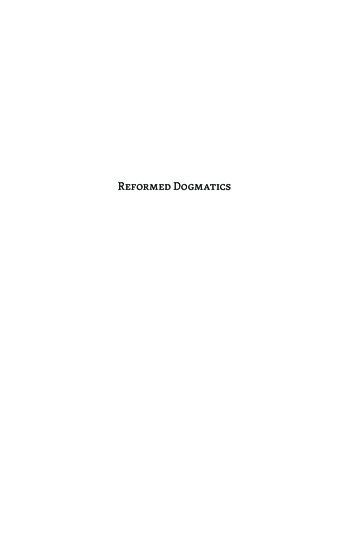
Transcription
Reformed Dogmatics
Vos during his professorship at the Theological Schoolof the Christian Reformed Church, circa 1888–1893.
REFORMEDDOGMATICSGeerhardus Vos, Ph.D., D.D. Volume One: Theology ProperTranslated and edited byRichard B. Gaffin, Jr.withKim Batteau, Associate EditorAnnemie GodbehereRoelof van Ijken
Volume 1: Theology ProperReformed DogmaticsCopyright 2012–2014 Lexham PressTranscribed from lectures delivered in Grand Rapids, MichiganFirst publication hand-written in 1896Originally printed in 1910Lexham Press, 1313 Commercial St., Bellingham, WA 98225LexhamPress.comAll rights reserved. You may use brief quotations from this resource inpresentations, articles, and books. For all other uses, please write LexhamPress for permission. Email us at permissions@lexhampress.com.Hardcover ISBN 978-1-57-799583-8Digital ISBN 978-1-57-799642-2Cover Design: Christine GerhartTypesetting: ProjectLuz.com
ContentsPreface . viiChapter One .1The Knowability of GodChapter Two .3Names, Being, and Attributes of GodChapter Three .38The TrinityChapter Four .77Of God’s Decrees in GeneralChapter Five .97The Doctrine of PredestinationChapter Six.156CreationChapter Seven .183ProvidenceQuestion Index .203Subject and Author Index .223Scripture Index .237
PrefaceThe Reformed Dogmatics of Geerhardus Vos (1862–1949), here appearingfor the first time in English, is a welcome publication for anyone wishingto benefit from a uniformly sound and often penetrating articulation ofbiblical doctrine. It will be of particular interest to those who are alreadyfamiliar with the work of Vos—the father of a Reformed biblical theology.1 Few, if any, among them have not experienced a growing appreciation of his profound and singular insights into Scripture. F. F. Bruce’scharacterization of The Pauline Eschatology is an apt description for hiswork as a whole: “indeed outstandingly great a rare exegetical feast.”2The Reformed Dogmatics stems from the period 1888–1893, whenamong other subjects the young Vos taught systematic theology (dogmatics) at the Theological School of the Christian Reformed Church,later renamed Calvin Theological Seminary. This Dogmatiek was firstpublished in Dutch as a hand-written manuscript in five volumes, in1896. It was subsequently transcribed and printed in 1910. While the1896 version is apparently in Vos’ own hand, the transcription is almost1For some reflections on his work in biblical theology (or “History of Special Revelation,” the designation he much preferred), and its significance, see my “Vos, Geerhardus,” in Dictionary of Major Biblical Interpreters (ed. Donald K. McKim; Downers Grove,IL: IVP Academic, 2007), 1016-19, and the literature cited there, 1019, and my “Introduction” in Geerhardus Vos, Redemptive History and Biblical Interpretation: The ShorterWritings of Geerhardus Vos (ed. Richard B. Gaffin, Jr.; Phillipsburg, NJ: P&R, 1980/2001),ix-xxiii; see also J. T. Dennison, Jr., The Letters of Geerhardus Vos (Phillipsburg, NJ: P&R,2005), 36–41, 49–59, and the editor’s “Introduction: The Writings of Geerhardus Vos,”in Danny E. Olinger, ed., A Geerhardus Vos Anthology: Biblical and Theological InsightsAlphabetically Arranged (Phillipsburg, NJ: P&R, 2005), 1–27.2On the front cover of the 1953 Eerdmans reprint.‹ vii ›
‹ viii ›Prefacecertainly by some other person or persons. But there is no good reasonto question that it was done with Vos’ full knowledge and approval. Thattranscription is the basis for this translation project.While this is not a critical translation, the goal has been to provide acareful translation, aiming as much as possible for formal rather thandynamic equivalence. The accuracy of the secondary sources Vos citesor quotes—usually by referring to no more than the author and titleand sometimes only to the author—has not been verified nor the exactbibliographic details provided. Explanatory footnotes have been keptto a minimum. Nothing has been deleted, no sections elided or theircontent summarized in a reduced form. Vos’ occasionally elliptical stylein presenting material, meant primarily for the classroom rather thanfor published circulation to a wider audience, has been maintained.The relatively few instances of grammatical ellipsis unclear in Englishhave been expanded, either without notation or, where the expansion ismore extensive, placed within brackets.Concerning the use of Scripture a couple of things are to be noted.Effort has been made to verify Scripture references, and occasional instances of typographical error, where the intended reference is clear,have been corrected without that being indicated. In Vos’ original, OldTestament verse references are to the Hebrew text, which varies occasionally from the numbering used in English Bibles. These referenceshave been changed in this translation to be consistent with Englishversification. Also, quotations occasionally follow the Statenvertaling3but are usually Vos’ own translation, whether exact or a paraphrase.Accordingly, rather than utilizing a standard English translation, theyare translated as Vos quotes them.English readers will now be able to explore the relationship betweenthe early Vos of the Reformed Dogmatics and his subsequent work inbiblical theology, begun in the fall of 1893 when he moved from GrandRapids to Princeton Seminary as the first occupant of its newly createdchair of biblical theology.4 Whatever differences that comparison maybring to light, it is safe to anticipate that the end result will substantiate3The state-commissioned Dutch translation first published in 1637.4The most extensive bibliography of Vos’ writings is in Dennison, Letters of GeerhardusVos, 89–110; on the Dogmatiek, 92. For a thorough survey of Vos’ life, see 13–85; on histime teaching in Grand Rapids, 25–26.
Preface‹ ix ›deep, pervasive and cordial continuity between his work in systematictheology and biblical theology. An important reference point in thisregard is provided by Vos himself in his comments on the thoroughlypositive, complementary relationship he as a Reformed theologian sawbetween the two disciplines. This point was present in his Princetoninaugural address in the spring of 18945 and echoed decades later, wellafter his retirement.6Another interesting question concerns the antecedents of theReformed Dogmatics, particularly those Vos may have considered itsmore immediate predecessors. Calvin is quoted most often, and thereis occasional reference to various figures in late 16th and 17th centuryReformed theology. However, there is no indication of current or morerecent Reformed theologians who substantially influenced him andupon whose work he sees himself as building. There are only two passing references to Charles Hodge in Volume One (both dissenting!). Thereis no mention of Abraham Kuyper or B. B. Warfield, although Vos waspersonally acquainted with both and corresponded with them duringhis time in Grand Rapids, sometimes touching on matters theological.This silence may be explained by the fact that their major works wereyet to appear.The appearance of the Reformed Dogmatics will disclose substantialaffinity with the Reformed Dogmatics of Herman Bavinck. This is tobe expected, since the slightly younger Vos (by seven years) considered Bavinck a good friend as well as a close theological ally. The firstvolume of Bavinck’s work (in Dutch), however, did not appear until1895, after Vos’ Grand Rapids period.7 Perhaps the later volumes of theReformed Dogmatics will shed more light on the question of influenceson Vos’ work.85“The Idea of Biblical Theology as a Science and as Theological Discipline,” RedemptiveHistory and Biblical Interpretation, 23–24.6Geerhardus Vos, Biblical Theology: Old and New Testaments (Grand Rapids: Eerdmans,1948), Preface, 23.7Vos provided lengthy and appreciative reviews of volume 1 (1895) and volume 2 (1897)of the Gereformeerde Dogmatiek soon after each appeared; see Redemptive History andBiblical Interpretation, 475–93.8For Vos’ side of ongoing correspondence with Kuyper, Bavinck and Warfield, see Dennison, Letters of Geerhardus Vos, 116–203, for the time prior to and during his GrandRapids period, 116–78. None of this correspondence sheds any light on the existenceof the Dogmatiek.
‹ x ›PrefaceVolume One, appearing here, deals with theology proper. Subsequentvolumes, scheduled to appear as the translation of each is readied, treatin order anthropology, Christology, soteriology, and in the final volume,ecclesiology and eschatology.9This project represents a collaborative effort without which it wouldnot have otherwise been possible. Particular thanks are due to thetranslators for their efforts in providing base translations of the various parts of Volume One and also to Kim Batteau for some translationreview. I have reviewed and revised their work and given the translationits final form.Thanks are due to Lexham Press for its commitment in initiating andsupporting this project, and to its editorial staff for their work. Specialthanks to the project manager, Justin Marr, for all his time and efforts,not least his ready availability to make suggestions and answer questions about procedures. Finally, it would be remiss not to acknowledgeindebtedness to the unknown person or persons responsible for thecareful transcription work done over a century ago. Those labors havemade this translation project immeasurably more feasible.R. Gaffin, Jr.January 2013Reissued August 20149Interestingly, and no doubt of some disappointment to some readers today, thereis no introduction (prolegomena) to systematic theology. It is unclear if—and if so,where—this area was covered in the curriculum of the Theological School at thistime and whether Vos or someone else taught it. My thanks to Dr. Mark A. Garciafor verifying this state of affairs from the resources available in the Heritage HallArchive at the Calvin College and Seminary Library, Grand Rapids, Michigan.
Chapter OneThe Knowability of God1. Is God knowable?Yes, Scripture teaches this: “that we may know the One who is true”(1 John 5:20), although it also reminds us of the limited character of ourknowledge (Matt 11:25).2. In what sense do Reformed theologians maintain that God cannotbe known?a) Insofar as we can have only an incomplete understanding of aninfinite being.b) Insofar as we cannot give a definition of God but only a description.3. On what ground do others deny God’s knowability?On the ground that God is All-Being. They have a pantheistic view of God.Now, knowing presumes that the object known is not all there is, sinceit always remains distinct from the subject doing the knowing. MakingGod the object of knowledge, one reasons, is equivalent to saying thatHe is not all there is, that He is limited.4. What response is to be made against this view?a) The objection that this view presents stems entirely from a philosophical view of God, as if He were All-Being. This view is wrong.‹ 1 ›
‹ 2 ›Reformed DogmaticsGod is certainly infinite, but God is not the All. There are thingsthat exist, whose existence is not identical with God.b) It is certainly true that we cannot make a visible representationof God because He is a purely spiritual being. But we also cannotdo that of our own soul. Yet we believe that we know it.c) It is also true that we do not have an in-depth and comprehensive knowledge of God. All our knowledge, even with regardto created things, is in part. This is even truer of God. We onlyknow Him insofar as He reveals Himself, that is, has turned Hisbeing outwardly for us. God alone possesses ideal knowledge ofHimself and of the whole world, since He pervades everythingwith His omniscience.d) That we are able to know God truly rests on the fact that God hasmade us in His own image, thus an impression of Himself, albeitfrom the greatest distance. Because we ourselves are spirit, possess a mind, will, etc., we know what it means when in His WordGod ascribes these things to Himself.
Chapter TwoNames, Being, and Attributes of God1. In what does the importance of the names of God lie?In this, that God through them draws our attention to the most important attributes of His being. This being is so rich and comprehensive thatwe need to have some benchmarks in order to understand the rest. God’snames are not empty sounds (like the names of people), but they havemeaning and contribute to our knowledge of God.2. What is the meaning of the name Elohim?1“He who is to be feared,” “the One who is full of majesty.” The ending im2is a plural ending. The singular is Eloah and appears first in the laterbooks of the Bible as a poetical form. The plural ending does not point toan earlier polytheistic conception, but signifies the plenitude of powerand majesty there is in God.3. What are the meanings of the names El and Adonai?El means “the Strong One,” “the Mighty One.” Adonai means “Ruler,”“Lord”; originally, “my Ruler,” “my Lord.”1Throughout Vos’ transliterations of Hebrew and Greek words are preserved—theyhave not been updated to conform to cur
The Reformed Dogmatics stems from the period 1888–1893, when among other subjects the young Vos taught systematic theology (dog-matics) at the Theological School of the Christian Reformed Church, later renamed Calvin Theological Seminary. This Dogmatiek was first published in Dutch as a hand-written manuscript in five volumes, in
